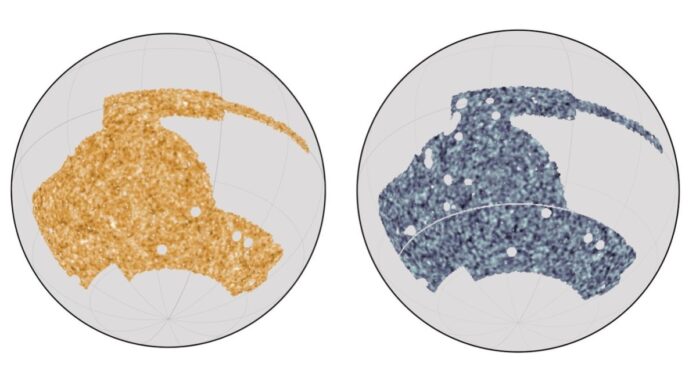Scientists have released one of the most accurate maps of the universe’s matter ever created, featuring precise measurements of its distribution throughout the cosmos.
One surprising revelation from the map is that matter isn’t as “clumpy” as our current best model of the universe suggests it should be, meaning something could be missing from our standard cosmological model.
By helping to reveal how matter in the very early cosmos was flung outward before it formed galaxies, stars and planets, the new map could give scientists a better understanding of how the universe evolved.
Related: Beautiful interactive map of the universe lets you journey through space-time almost to the Big Bang
Following the creation of matter and the rapid expansion during the Big Bang around 13.8 billion years ago, the universe expanded and that matter spread outward. As this matter, mostly in the form of hydrogen and helium, cooled, it led to the formation of the first stars, which then synthesized heavier elements.
By tracking the path of this primordial matter as it spread outward and looking at how it is distributed today, scientists can rewind time and recreate that early epoch of the universe. Doing this, however, requires a huge amount of astronomical data.
For the new map, the team used data collected by the Dark Energy Survey in Chile and the South Pole Telescope. This combination of observational methods helped the team ensure that an error in one set of measurements wouldn’t undermine the overall results.
“It functions like a cross-check, so it becomes a much more robust measurement than if you just used one or the other,” Chihway Chang, an astrophysicist at the University of Chicago and co-lead author of the research, said in a statement.
Dark matter, too
Both the Dark Energy Survey, which surveyed the sky between 2013 and 2019, and the South Pole Telescope use a technique called gravitational lensing. Because mass causes space-time to warp, when light travels from a background object past a massive foreground object, it bends the path of this light. In some cases, this results in the foreground object acting as a natural lens, amplifying the light from the background object. The bigger the mass, the greater the curve in space-time and the more extreme the effect on light, meaning massive galaxies in our line of sight make brilliant gravitational lenses.
While gravitational lensing is good for tracking the normal, everyday matter that makes up stars and planets, this technique is also great at tracking dark matter, a mysterious form of matter that makes up about 85% of the universe’s mass. Dark matter is invisible because it doesn’t interact with light, but its existence can be inferred by gravitational lensing because it does interact with gravity.
The study authors said they used the two data sets to pinpoint the locations of the universe’s matter more precisely than was possible in previous attempts.
While most of the results agree with current theories of universal evolution, there were signs of an interesting quirk — one that past analysis attempts have also spotted.
“It seems like there are slightly less fluctuations in the current universe than we would predict assuming our standard cosmological model anchored to the early universe,” Eric Baxter, an astrophysicist at the University of Hawaii and a member of the research team, said in the statement.
The results suggest that the universe is less “clumpy” — clustering in specific areas rather than being evenly spread out — than previous models of the cosmos had found.
This may indicate that something is missing from our model of the universe. However, to solidify this idea, the disparity will have to be apparent in more surveys and mapping projects.
The current project is significant because it mixes two very different sources of data to obtain useful information and could point to future similar collaborations as increasingly powerful observatories come online.
“I think this exercise showed both the challenges and benefits of doing these kinds of analyses,” Chang said. “There’s a lot of new things you can do when you combine these different angles of looking at the universe.”
The team’s research was published Tuesday (Jan. 31) as three separate studies in the journal Physical Review D.
Follow us on Twitter @Spacedotcom or on Facebook.

